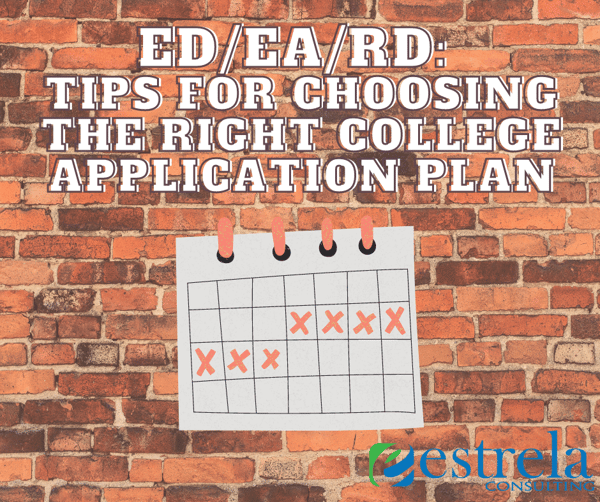
ED, EA, RD…the alphabet soup that describes college application plans can be confusing. Let’s dive into what you need to know about each, and more importantly, how to determine which plans are the right ones for you.
Early Decision
Early Decision (ED) plans are for students who absolutely know their first-choice college and are ready to commit. A student can only apply to one college using ED, and if accepted, they are obligated to attend. Since the decision is binding, applications to all other colleges must be withdrawn upon acceptance. The family must be prepared to pay their share of the cost, as determined by the college’s Net Price Calculator, and there is no opportunity to compare financial packages with other schools. Why would a student commit through an ED plan? Colleges often report higher acceptance rates for Early Decision, although these numbers generally factor in recruited athletes and a somewhat stronger applicant pool. ED deadlines are typically November 1st or November 15th, and decisions are released between mid-December and mid-January.
Early Action
Early Action (EA) plans use the same early timeframe as ED (November deadlines, early winter notification), but are not binding decisions. Students can apply to as many schools as they’d like using EA deadlines, and are free to compare their offers. They have until May 1st – the national decision date – to make their choice. This is a great option for students that have their application materials ready to submit by November and would like to have their decisions back by the holidays. Earlier notifications can relieve some of the stress that comes along with waiting for decisions.
Regular Decision
Regular Decision (RD) plans are used by the majority of applicants and require no commitment. Students may use as many RD application plans as they would like. RD deadlines are usually January 1st or later, with decisions forthcoming in February or March. This is a great option for students that require a little more time to prepare their applications and essays. It also provides more time for additional standardized testing and allows the student to complete their first semester of senior year coursework. An upward trend in grades during the beginning of senior year can be a boost to an application!
What should a student consider when deciding which plan to use?
When thinking of applying early (ED or EA), the student must have done their homework and know that the college they are applying to is a good fit. They must also be ready to “put their best foot forward” in their application materials. Answer these questions to determine if an early plan is right for you:
- Did I finish my junior year with strong grades that are reflective of my best work?
- Is my testing complete, and do I have what I consider to be my best effort test scores?
- Have I researched the school thoroughly and feel that it will be a good fit – academically, socially, and financially?
- Is my application well thought out and carefully prepared, with an essay that has been through multiple revisions and reflects my best work?
- And if contemplating using an ED plan, have I carefully considered the binding nature of the commitment, and am I absolutely sure that this is the college I want to attend? Also, is my family sure that we are prepared to pay our expected cost?
If you can’t answer “yes” to each of these questions, it may be best to wait until the later RD deadline. Frequently, students benefit from another semester of strong grades and additional test dates to present their best application effort.
All plans require the same set of application materials, although Early Decision also requires a commitment agreement. Ultimately, a student should pick the decision plan that best fits with where they are in the process. The quality of the application should be the most significant driving factor in whether or not to use early vs. regular deadlines. Hang in there, seniors! You’re in the home stretch!


